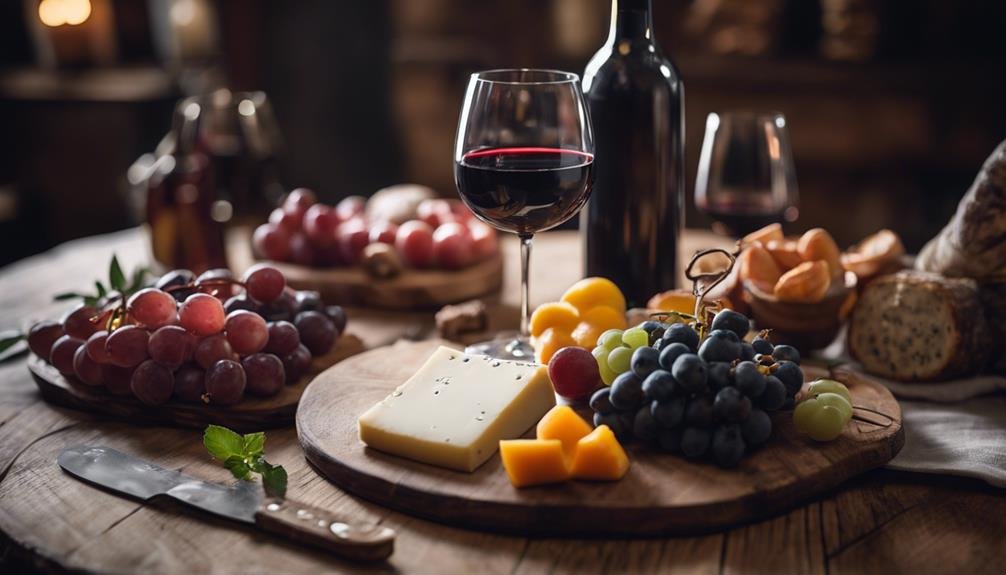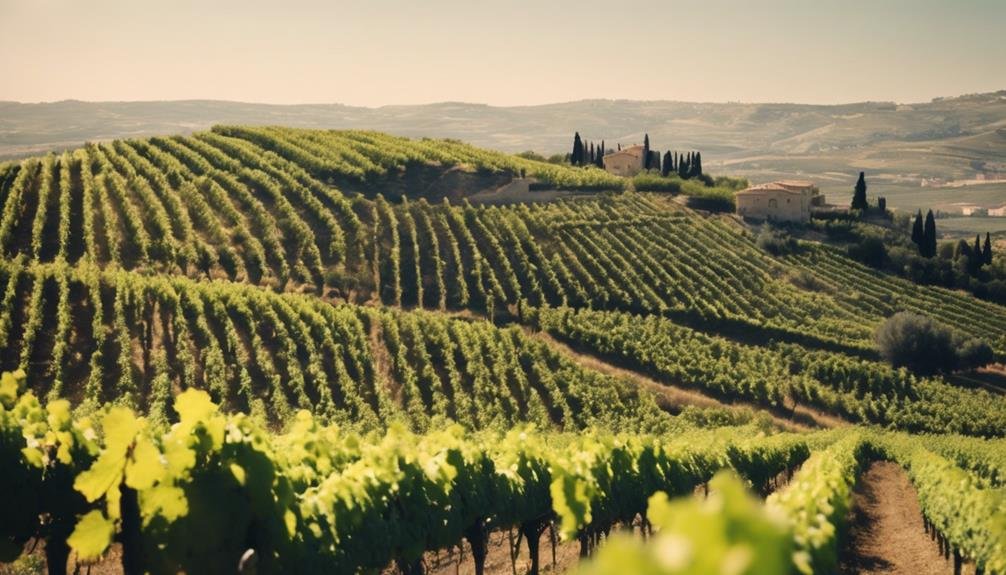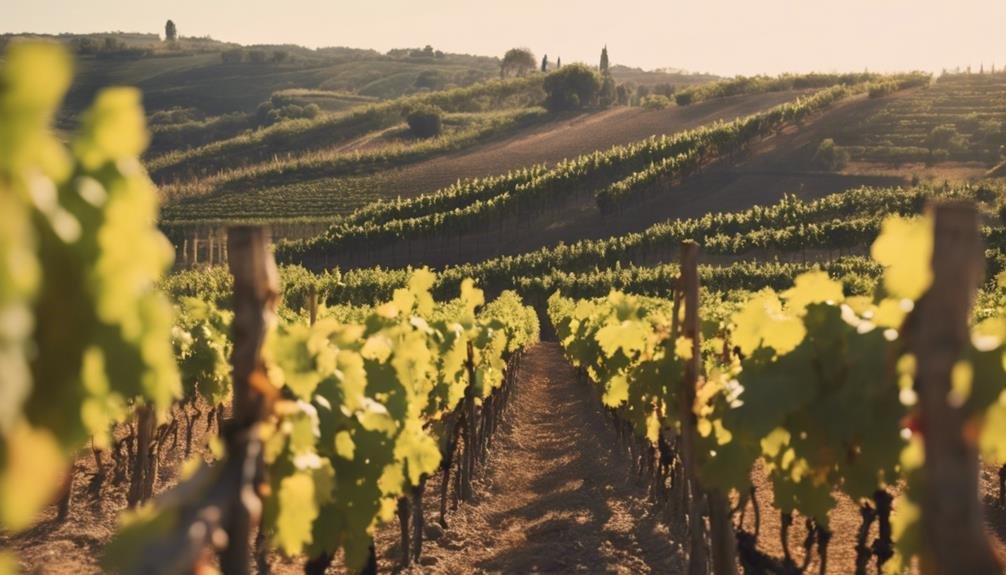In the late 1990s, Nero d'Avola saw a resurgence led by esteemed producers embracing modern winemaking techniques. This quality enhancement through advancements in viticulture and vinification elevated its global presence. Bold fruit profiles akin to Cabernet Sauvignon and Syrah, with moderate acidity and alcohol content, define Nero d'Avola wines. Aging potential of up to 10 years allows for nuanced flavors to develop. Pair with rich, meaty dishes or spice-infused fare for an excellent match. Serve between 60–68 ºF in an oversized red wine glass to truly appreciate its full-bodied nature. Discover Nero d'Avola's versatility and distinct regional influences.
History of Nero Davola Resurgence
In the late 1990s, Nero d'Avola experienced a remarkable resurgence, spearheaded by renowned producers such as Planeta, COS, Curto, and Donnafugata, marking a significant revitalization in the wine industry.
This rise of Nero was propelled by a shift towards modern winemaking techniques, where these esteemed winemakers embraced innovation and quality. By leveraging advancements in viticulture and vinification, they were able to elevate Nero d'Avola wines to new heights, enchanting the palates of wine enthusiasts globally.
Through a dedication to craftsmanship and a deep understanding of the grape's potential, these producers paved the way for Nero d'Avola to reclaim its status as a distinguished varietal, showcasing the grape's unique characteristics and versatility in the domain of winemaking.
Characteristics of Nero Davola Wine
Following the resurgence led by prominent producers in the late 1990s, Nero d'Avola wines have distinguished themselves through their unique characteristics and versatile winemaking potential.
Nero d'Avola wines are known for their bold fruit profiles, ranging from black cherry to prune, similar to Cabernet Sauvignon and Syrah. They typically exhibit moderately high acidity and have an alcohol content between 13.5%–14.5% ABV.
These wines offer a diverse range of flavors, falling into three categories: Primary, Secondary, and Tertiary.
Additionally, Nero d'Avola wines have a significant aging potential, with most varieties able to confidently age for up to 10 years. This aging process can enhance the wine's complexity and develop more nuanced flavors over time.
Food Pairing Suggestions

When considering food pairings for Nero d'Avola wines, it is essential to complement the bold fruit-driven flavors and robust characteristics of the wine with dishes that enhance its complexity.
Nero d'Avola pairs well with savory dishes such as rich, meaty options like oxtail soup and beef stew. The wine's flavor profiles, ranging from black cherry to prune, also make it an excellent match for spices like anise, orange rind, and cocoa powder.
Vegetarian dishes featuring ingredients like black lentils and shitake mushrooms can also be enhanced by Nero d'Avola. This wine is particularly suited to enhancing the flavors of gamier meats, making it a versatile option for a range of dishes that benefit from its bold and full-bodied nature.
Serving and Storing Tips
To guarantee a premium experience with Nero d'Avola wine, appropriate serving and storing techniques are essential for preserving its flavors and characteristics.
- Temperature Control: Serve Nero d'Avola in an oversized red wine glass at a room temperature of 60–68 ºF (16–20 ºC) to allow its bold fruit-driven flavors to shine.
- Aging Potential: Most Nero d'Avola wines can confidently age for up to 10 years, enhancing complexity and depth over time.
- Storage Conditions: Store Nero d'Avola in a cool, dark place away from direct sunlight to maintain its quality and prevent premature aging.
- Cost Consideration: With a price range of $15–20 (US), Nero d'Avola offers excellent value for its aging potential and flavor profile.
Regions Where Nero Davola Thrives

Thriving in arid climates and heat, Nero d'Avola is primarily cultivated in Sicily, with select vineyards also found in California and South Australia. Sicilian vineyards have long been the heartland for this grape, with its ability to withstand the intense sun and dry conditions of the region. In recent years, the grape has also found a new home in regions like California and South Australia, where winemakers are exploring the grape's potential and the Australian growth opportunities it presents. The table below showcases the key regions where Nero d'Avola is thriving:
| Region | Main Characteristics |
|---|---|
| Sicily | Traditional, arid climate |
| California | Emerging, diverse styles |
| South Australia | Promising, experimental |
Frequently Asked Questions
Can Nero Davola Wines Be Aged in Oak Barrels?
Yes, Nero d'Avola wines can be aged in oak barrels. Oak aging enhances complexity, adding flavors of vanilla, spice, and toast. It can soften tannins and impart a smoother texture. However, alternative methods like stainless steel or concrete can also retain freshness.
Are There Organic or Biodynamic Nero Davola Wines Available?
Yes, there are organic and biodynamic Nero d'Avola wines available. Producers are increasingly embracing sustainable practices in vineyard management. Look for certifications or information on labels to identify these eco-friendly options in the market.
What Are Some Unique Terroir Characteristics of Nero Davola Grapes?
Nero d'Avola grapes exhibit unique terroir characteristics through their ability to thrive in arid climates with sandy, limestone-rich soil. The microclimates of Sicily, California, and South Australia influence the grape's bold fruit flavors and moderate acidity, resulting in diverse wine styles.
How Does the Climate Impact the Flavor Profile of Nero Davola Wines?
Climate influence plays a pivotal role in shaping the flavor profile of Nero d'Avola wines. From enhancing fruit intensity to balancing acidity, varying climates impact aging potential and terroir nuances. Organic farming further refines flavors, making them ideal for dessert pairings.
Are There Any Dessert Pairings That Complement Nero Davola Wines?
When considering dessert pairings for Nero d'Avola wines, seek sweet pairings like chocolate desserts and cheese platters. These wines complement savory dishes well, making them a versatile option for post-dinner treats that balance rich flavors harmoniously.
Conclusion
To sum up, the resurgence of Nero d'Avola in the world of wine highlights a fascinating journey driven by esteemed producers and the unique characteristics of this grape variety.
With bold fruit-driven flavors and a diverse range of tasting experiences, Nero d'Avola has found its place on tables worldwide.
Paired exquisitely with rich, meaty dishes and thriving in arid climates, this varietal continues to captivate connoisseurs with its distinct character and compelling narrative.
